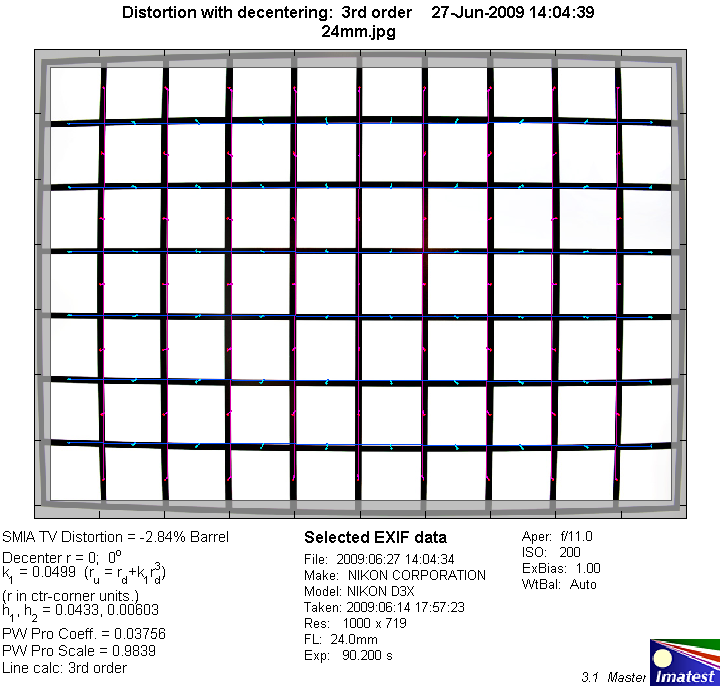|
Page 2 of 3

Distortion
At 24 mm the lens shows a significant amount of barrel distortion reaching almost 3 %. The distortion flips over to the pincushion type at 40 mm and with roughly 1 % can be an issue with certain subjects. At 70 mm the pincushion distortion is down to 0.5%, which can be considered distortion-free for most photographic applications. Especially at the short end, that's fairly large amount, however the good news is that it is uniform distortion that is not too complicated to correct by software in post processing (at the expense of resolution and a little field of view, of course).
|
Move the mouse cursor over the focal length text marks below to observe the respective distortion
|
| 24mm |
40mm |
70mm |
|

|
The chart above has a real-world size of about 120x80cm.
Vignetting
With a fast zoom lens some vignetting has to be expected on a FX camera. Wide open, the amount of vignetting is very visible (also see the samples on page 3 of the reivew). Stopping down helps to reduce vignetting considerably. From f/5.6 onwards vignetting may still be visible in critical scenes, however for most subjects it's probably not field relevant.
We're performing our vignetting analysis based on
(uncorrected) JPEGs straight from the camera. The JPG engine of the Nikon D3x features a rather flat
gradation curve, thus has a moderate contrast characteristic, resulting in comparatively low vignetting figures - the
corresponding Canon figures are roughly 40% higher due to the more
aggressive default contrast setting.

MTF (resolution)
The lens delivers very high resolution figures on the D3x.
At all focal lengths the center resolution is excellent wide open already and remains on this very high level until diffraction kicks in at f/11.
At 24 and 40 mm the borders and extreme corners follow a bit behind with good resolution wide open. Stopped down to f/4 the borders reach very good values, whil the extreme corners require f/5.6 to reach that level. At 70 mm, the extreme corners actually give higher resolution than the borders at all measured apertures.
For a standard zoom lens, this is an impressive performance.
When we reviewed this lens on our DX test camera we discovered a rather huge amount of field curvature at 24 mm. On the D3x it turns out the image field is not simply curved, but has a dent where the border of the DX frame happens to be. Further towards the edges, the images field folds back again.
Please note that the MTF results are not directly comparable across the different systems!
Below is a simplified summary of the formal findings. The chart shows line widths
per picture height (LW/PH) which can be taken as a measure for sharpness.
If you want to know more about the MTF50 figures you may check out the corresponding
Imatest Explanations

Chromatic Aberrations (CAs)
Chromatic aberrations (color shadows at harsh contrast transitions) are a weak spot of this lens, at least at the lower focal lengths. At 24 mm the values are already rather high with a maximum value of 1.85 pixels wide open, but at 40 mm the situation is even worse: a peak value of 2.41 pixels and thoughout the tested aperture range never below two pixels.
The good news is that CAs are no isse at 70 mm. In addition, CAs can easily be corrected in software or by the camera itself.

Bokeh
The Nikkor 24-70 is not the primary weapon of choice for portraits, but since it is meant as an allround tool and as fast as it gets for a FX zoom lens it may well be used for this purpose, too. Thus, the quality of the bokeh (out-of-focus blur) is an important aspect for some users. Since it is probably the most used focal length for this purpose the bokeh tests were shot at 70 mm. Wide open the lens shows a visible amount of outlining arouns highlights, but apart from that the boekh is very smooth and buttery, especially for a zoom lens with aspheric elements.
Thanks to 9 rounded aperture blades, background highlights remain their circular shape throughout the whole aperture range.

Bokeh Fringing / Longitudinal Chromatic Aberrations (LoCA)
LoCAs (non-coinciding focal planes of the various colors) are a common issue with relatively fast glass. As you can
notice below the halos have different colors - magenta (red + blue) in front the focus point
and green beyond. Truly "apochromatic" lenses don't show LoCAs but these lenses are very rare especially
below 100mm. Unlike lateral lateral CAs, LoCAs cannot easily be fixed in post processing.
At it longest focal length of 70 mm (which we used here) the lens shows a moderate amount of LoCAs wide open, which is considerably reduced by f/4 already and no longer field relevant at f/5.6 and beyond.
|